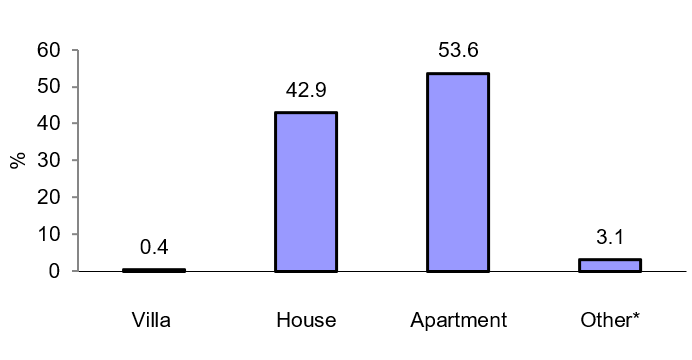A Press Release by the Palestinian Central Bureau of Statistics (PCBS)
on the Occasion of World Habitat Day and Arab Housing Day Titled:
"The Humanization of Cities is One of the Pillars of Mental Health for Community Members"
The first Monday of October of each year coincides with the World Habitat Day, according to the recommendations of the United Nations, and the Arab Housing Day, based on the decision of the Council of Arab Ministers of Housing and Reconstruction. The Council decided the theme of the Arab Housing Day for the year 2023 to be "The Humanization of Cities is One of the Pillars of Mental Health for Community Members".
On this occasion, PCBS presents the main indicators for housing and housing conditions in Palestine that are related to Sustainable Development Indicators.
Population of Palestine, in Mid-2023, is estimated to be 5.48 Million People
The population of Palestine is estimated to be 5.48 million people in mid-2023, 78% of the population are living in urban areas while 14% are living in rural areas and 8% in refugee camps. Also, the population density was estimated at 910 persons/km2 in mid-2023 in Palestine (575 persons/km2 in the West Bank and 6,102 persons/km2 in Gaza Strip).
81% of Households in Palestine Live in Owned Housing Units
81% of the households in Palestine live in owned housing units, 87% in the West Bank and 70% in Gaza Strip in 2022.
In addition, 7% of households in Palestine live in rented housing units (5% in the West Bank and 10% in Gaza Strip). Results also showed that 12% of households in Palestine live without payment and as in exchange of labour (7% in the West Bank and 20% in Gaza Strip) in 2022.
More than Half of the Palestinian Households Live in Apartment Type of Housing Units
54% of the Palestinian households live in apartment type of housing units, 43% of the households live in houses, and less than half a percent of the households live in villas, and 3% of the households live in other types of housing units as an independent room, tent, marginal...etc, in 2022.
Percentage Distribution of Households in Palestine by Type of Housing Unit, 2022

*Other includes (Independent Room, Tent, Marginal…etc).
In Average 1.5 Persons per Room in the Housing Unit in Palestine
Results showed that the average housing density (number of persons per room) in Palestine in 2022 was 1.5 persons per room: 1.5 persons per room in urban and rural areas, and 1.8 persons per room in refugee camps.
The average housing density (number of persons per room) by region was 1.4 persons per room in the West Bank and 1.7 persons per room in Gaza Strip.
5% of Households in the West Bank Live in Overcrowded Housing Units While 9% in Gaza Strip
Data indicated that 6% of households in Palestine live in housing units with three persons or more per room (5% in the West Bank, and 9% in Gaza Strip), and by type of locality: 6% of households in urban and rural areas, and 9% in refugee camps in 2022.
Data indicated that the average number of rooms in a housing unit in Palestine was 3.5 room in 2022, where 3.5 room in urban and 3.6 room in rural areas, compared to 3.2 room in refugee camps. The average number of rooms in a housing unit in each of the West Bank and Gaza Strip was 3.5 room in 2022.
4% Only of Gaza Strip Population Have Access to Safely Managed Water that is Free of Pollution
As for safely managed water resources (defined as improved sources, used in the dwelling, available when needed and free from pollution (free of E-Coli bacteria)), data indicates that 40% of the population in Palestine have access to safely managed water, (66% in the West Bank, compared to 4% in Gaza Strip). As for the type of localities, these percentages were distributed to 36% in urban areas, 67% in rural areas, and 25% of the population in refugee camps in 2020.
59% of the Palestinian Households Live in Housing Units Connected to Wastewater Networks
Data indicated that 59% of the Palestinian households in 2020 used wastewater networks to dispose their wastewater, 28% of households used septic tank, 12% of households used pit latrine and 2% of households used other methods to dispose their wastewater; 96% of households in refugee camps, 64% in urban areas and 10% in rural areas, respectively.
Most Housing Units in Palestine has Improved Sanitation
Data indicated that 99% of the Palestinian households in 2020 used improved sanitation, which includes piped sewer system, septic tank and pit latrine. By type of locality, 99% of households in urban areas and refugee camps, and 97% in rural areas use improved sanitation.
An Increase in the Number of Licensed Housing Units for the Year 2022 Compared to Previous Years
The number of new and existing licensed housing units for the year 2022 reached 23,148 licensed housing units in Palestine, with an average area of 167.3 m2, distributed over 21,447 licensed housing units in the West Bank with an average area of 167.0 m2 and 1,701 licensed housing units in Gaza Strip with an average area of 171.0 m2 according to the administrative records of building licenses in 2022.
 عربي
عربي